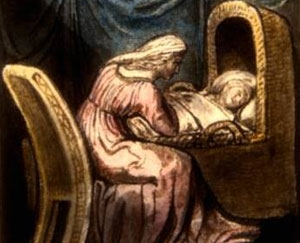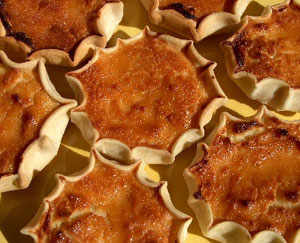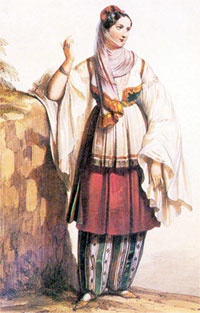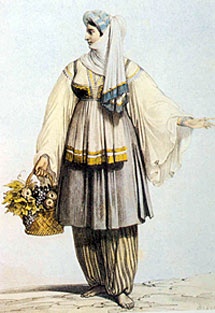Santorini Local Customs
Every place in Greece has its own habits and traditions.
Most of them in Santorini are still alive being a part of the populations daily life.

Cradlesong
Thirean mothers would lull their babies to sleep with nice ancient verses most of the still existing in Santorini. Every verses is full of feelings and motherly tenderness.
"Sleeplittle star, sleep down, sleep young moon
they brought your crable with a perl
Sleep as sugar, wake up as honey
I will give you water from the angels."
Easter Habits

Local traditions are tiedly inolved with smells and tastes. Bakeries of all villages of Santorini are petty busy during the Easter days. The housewives all day long are coking cheese pies, buns, easter-cokies and melitinia. There is a local phrase about this: "as long as the swallows bring us the Spring, indeed, melitinia bring to Santorini people the Easter".
The Epitaph decoration in the island begins early in the morning of Good Friday by women and girls of the village with flowers from their garden. After that follows the Unnailing ('Apokathilosi') and from that moment there is only monastery bells sounds. The evening the Epitaph Procession takes place around every village.
In Pirgos thousands of litle tins full with oil aer setting on fire at every path the Epitaph will pass by, creating an increadible sight full of contrition.
Women sprinkle with Cologne the Epitaph followers.
Traditional Costumes
All Thirean women inside and outside their house ought to wear scarfs nicely bound on the head slightly upwards to show the forehead. Only the married woman could accept her visitors not wearing scarf having. Washed her hair and un washed it hair and un washed it in oil and vinegar. The hair would shine and would be knit in two thick braids over the head of the young woman.
Until the beginning of out century women would look after hair styling which was the relative to their age and social class.
The same with the Thirean�s woman clothing especially the festive one that wasn�t to simple as is today. Metres of tissue were consumed to make petticoats the corsets and the bodices that women used to wear in an island- like style with some hair showing. They didn�t any cosmetics or put any ornaments, at least not the villagers, only a golden cross in race occasions. The hobble women in Santorini would decorate their chignon with pincers, safety e. t .c.
Men when they wore their festive fit, should wear a cotton underwear mean to protect them from winter�s cold and absorb the sweet in summer time.



Founding a new House
"My blessing, child, to the four streets of your house".
On the day the workers dug the foundation of the house the owner would call the priest to sanctify and slaughter a cock in one of the streets. Also the parents would give their blessing in every corner of the house by throwing coins. This same blessing is given even today to their children to show that parents blessing supports the house. Apart from the coins, they put, in every corner of the foundation, a cross. These crosses are kept into the shrine from Palm Sunday. After the sanctification of the house, the housewife brings a plate with sesame honey and the landlord some raki to treat the guests.
The Thireans respect and preserve the religious traditions. This is proved by the existence of 300 and more churches and chapels on the island.
Mariages

When a young man or woman reached the age of mariage, they couldn�t see each other or communicate in any way. The choice of a girl�s husband was made by the master of the house and the mother. When a young man flirted with a girl, he would either himself or his parents ask her from her parents.
When the parents agreed to it, they discussed the dower. In those years given that they had a fortune, they would give the boy or the girl their share. When the discussions were over they would begin to prepare the wedding.
The weddings in Santorini take place usually on Sundays. On the Thursday before, all the girls of the village would gather to the bride�s house to break the almonds and make the sugar-plums. On Fridays they would make the bride�s bed and they would throw rice on it so that the wedding is solid like rice and sugar-plums to make it sweet.

On the wedding day early at noon, the father of the groom would climb on the roof to signal the beginning of the wedding shooting once. The violists were getting ready to accompany the bride while a woman was going from door to door inviting the people to the wedding saying the same phrase: ``come to the wedding``. It was always the same woman and when she couldn�t do it any more she was succeeded by another.
The violists were notified and by playing they stopped outside the best man�s house. The guests take the best man to the bride maid�s house, then go to the groom�s house and all together to the couple�s house.
The villager�s priest would take the best man after the ceremony, to the closest vineyard, to cut the bridal garlands. The priest would cut three branches from a vine, blessed them and sprinkled them with white wine. He then gave them to the best man. The wine which the branches were sprinkled from shouldn�t return to the couple�s house and the bottle should be broken into pieces.

Sited round a big table laid on a white tablecloth, girls start decorating the garlands. First they fold the vine branches with cotton, then with ribbons and finally they faster the lemon flowers with golden thread. Only after the decoration is finished, they all leave for the church.
Before the mystery begins, the bride and groom worship the icons and kiss their parents� hands.
After the mystery is over, the "ferta" begins. This is an old custom. All the guests must throw some money in the plate. This custom goes back then when people wanted to support the priests who were usually poor. As soon as the newly wedded appear to the door of the church the violins as well as the explosives start their own tune, following the couple from the church to their house. At night they invite all the family and feast for two or three days.
The newly wedded put the wedding garlands in a box near the icons where they stay until they die and are put into the grave of him who dies last.

Birthday
Those years, they didn�t celebrate birthdays with candles and cakes, not the farmers anyway. They still don�t up today because in Santorini the nameday is mainly celebrated.
But when the child was one year old, all the relatives were invited to celebrate his birthday. This happened only once. This birthday was very different. They put the little boy in front of a big sifter in which they put some objects whether it was a boy or a girl. For the boy it was a paper boat, a trowel, a wooden measure, an ink vase, a shoe-last, a barley bread e.t.c. If the boy touched the boat he would become a sailor, the pen he�d love letters and so forth. That way they would predict the child�s profession or so they believed.
Traditioanal Tomato Jelly Preparation

The cultivation of tomato in Santorini begun in the 20th century and up today was one of the main products.
The semens were planted in February and in May they protected the tomato from the wind.
In the midst of June the vintage would begin after the procedures of making tomato jelly had already finished. The tomatoes were transferred to the jelly�s canava. There was a wooden trough split in two, a wooden cone with a toothed cylinder and a scraper. The tomatoes were thrown in the wooden machine by the cone of almost 60 kilos capacity. A worker would move the hand of the cylinder and the tomatoes would bread and transform into jelly. The jelly would fell in the scraper, then in the trough where a worker rubbed the jelly on the scraper and took off the clays thrown in the mangano. Another worker would take the jelly and gather it in the strainer to take the semens off. Thus, on the left side of the trough there was pure juice, which they transferred in a big boiler. After the boil they would put it in big barrels and sell it.
June 23rd
On the evening of June 23rd, the feast of St. John the Baptist, all May wreaths are gathered and burned in bonfires in most villages on Santorini and children and adults alike jump over the fire for good luck.





